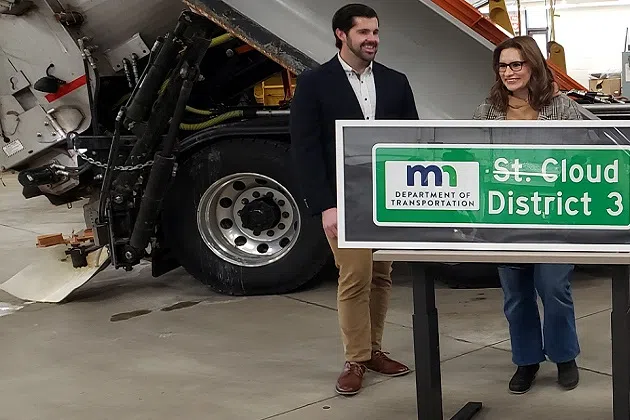(KNSI) – The number two politician in the state made a stop in St. Cloud on Thursday to highlight some of the proposals within this year’s capital budget.
The Walz Administration is looking to spend $20 million to upgrade Minnesota Department of Transportation facilities, with a priority on the District 3 building off of Highway 15.
Lieutenant Governor Peggy Flanagan says it is an investment that benefits everyone. “This is a bipartisan effort. When you drive on the roads, roads don’t care if you’re a Democrat or a Republican.”
Flanagan expanded on the idea that MnDOT is an aspect of government everyone can support. “I think when we talk about state government, people don’t always know what that means or what that looks like. It looks like this. It looks like this incredible equipment, it looks like the incredible people who do this work every single day.”
The facility’s machining and maintenance shop was built in 1969 and faces several challenges in ensuring the area’s construction and snowplow fleets are in top shape.
In many ways, the world has passed the cramped shop by. Every vehicle then was a single axle and gas-powered, much smaller than today’s fleet. Staff there say it requires creative thinking to work in the antiquated space.
Fleet Manager Mark Loxtercamp says the modern fleet is heavier, wider, and taller, and that is true for all four seasons. “So, we’ve gone to tandem trucks, much larger boxes, taller, carry more product, heavier axles. And then our plows, and especially our wings, have gone from a nine-foot size, progressed to 11-foot long, and now we’re actually getting 12-foot-long wings.”
If a plow breaks down in a winter storm, the vehicle is towed back to the shop but has to be offloaded outside the building since the stalls aren’t big enough to fit both. They must also remove the plows so the vehicles can fit through the doors.
Another issue is the low ceiling. Most of the work on a snowplow is on the electronic components. The hydraulic arm has to raise the rear bed to get to many of the wires. Staff often work with only inches to spare, above and to each side, which is dangerous.
A crane is used if the engine or other heavy parts must be replaced. Loxtercamp says it is hard to maneuver the crane to the right position to aid with the repair.
A 2001 expansion provides storage space for the vehicles, but it is located on a different wing of the building, and staff say sending tools and parts between the two units is inefficient. Budget constraints mean they can’t just double up on parts inventory, either.
Loxtercamp says the pinch is felt most when there is a late winter storm. The striper truck, which paints the roads, and the snooper truck, used for bridge inspections, are huge and require preventative maintenance before the summer season.
“They all need to be going as soon as possible because our summers are kind of short around here. So, we basically try to bring them in in late February and March. The challenge we come into is when we have that March storm. One of those larger units can take up almost half our shop.”
Resources are tied up when there is a crush of snow plows needing repair simultaneously. Loxtercamp says wear and tear and mechanical breakdowns drive some of the need for plow repairs. Another factor is accidents. His district covers all the way to Baxter. When whiteout conditions hit in rural areas, it is difficult for drivers to see the slower plows until it is too late, even if their lights are flashing.
District Three has 73 snow plows with an expected life of 14 years. Loxtercamp says roads coated in snow and ice often create unscheduled maintenance needs.
___
Copyright 2024 Leighton Media. All rights reserved. This material may not be broadcast, published, redistributed, or rewritten, in any way without consent.










